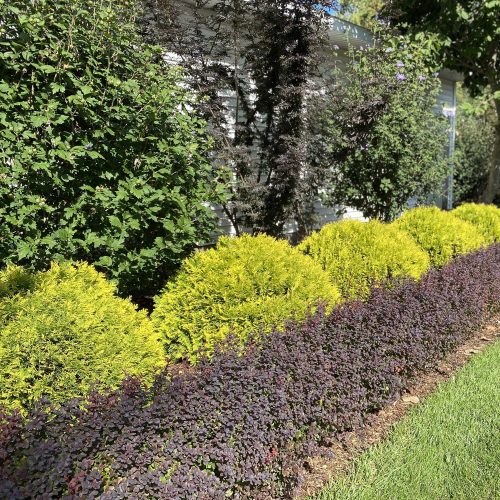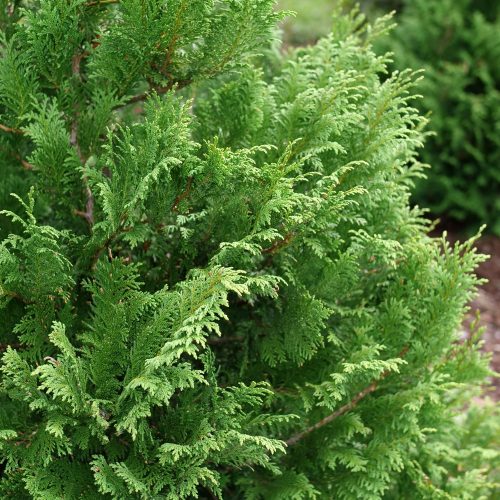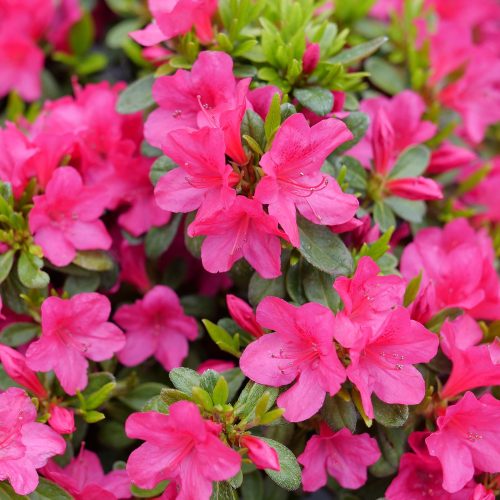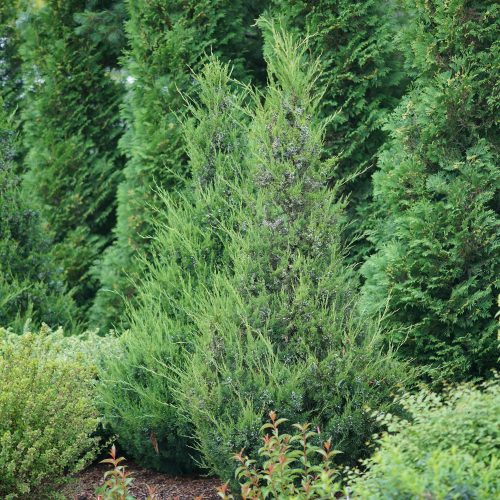Pruning can be a challenging topic for gardeners to master, so let’s tackle the topic of pruning evergreen trees and shrubs here.
When we talk about “evergreens” in general terms, we are describing plants that don’t lose their leaves in the winter. They are the opposite of “deciduous” plants which lose their leaves in the fall and sprout new ones again in the spring.
At Garden Crossings, we offer two main types of evergreens:
- Broadleaf and flowering evergreens
- Needle or scale-like foliage evergreens
You will find lists of each of these types of plants at the end of this article.
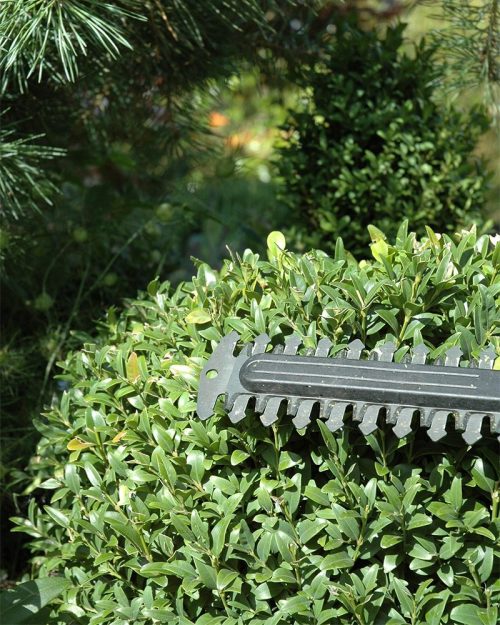
Why Should You Prune Evergreens?
Not all evergreens require pruning. However, some reasons you might prune your evergreens include: to remove dead, diseased or broken branches; to maintain their shape; to keep them to a specific size; to increase the density of their branching.
The One Thing You Should Never Prune
There are definite dos and don’ts when it comes to pruning evergreens. Most mistakes can be rectified over time except one: pruning the leader. Never prune the leader of an evergreen tree or shrub that has apical dominance, meaning a plant that grows to a single point like the top of a Christmas tree. The leader is the main shoot which controls the growth of the other branches around it to maintain dominance at the top of the plant. Removing it will cause the evergreen to lose its natural form, which may make it look unsightly over time.
Choose Wisely and You Won’t Need to Prune
Unless you really enjoy pruning and have the time, energy and tools to do it often, it’s wise to select varieties of evergreens that won’t require much pruning. Newer cultivars are often selected for their naturally tidy, compact form that doesn’t require much human intervention to maintain. Their smaller size will keep them from rising above your windowsills, blocking your walkway and crowding out nearby plants. Consider an evergreen’s mature size and the space you have for it carefully before you buy.
When and How to Prune Specific Types of Evergreens
Now, let’s talk about the most important aspects of pruning evergreens – the when and how. Not all evergreens should be pruned at the same time and in the same manner. However, one rule of thumb that applies to all evergreens is that they should not be pruned after midsummer. Doing so will encourage the plant to produce soft new growth that won’t have sufficient time to harden off before winter and will likely be damaged by the cold.
Consider which types of evergreens you are growing from those described below, then follow the specific pruning recommendations for each.
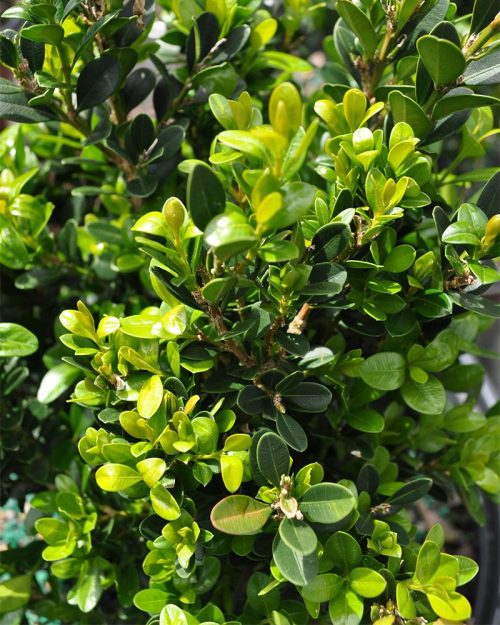
Pruning Boxwood, Boxwood-like Shrubs, Holly, Yew and Arborvitae
When to Prune: Prune once the new growth has emerged but is still soft and lighter green than the mature leaves. Typically, this is around late spring to early summer, which is early to mid-June in Michigan.
How to Prune: These types of shrubs typically respond well to shearing with electric or gas powered hedge trimmers or pruning shears. If only a few branches need to be cut, you could use hand pruners. Shear the plant all over to achieve an even shape, taking care to always keep the base of the shrub wider than the top. If the top is wider, it can shade out the lower portion, causing some of the lower leaves to drop.
It is not necessary to remove brown foliage from the center of these types of evergreens, should that occur, as this is a natural occurrence due to lack of sun exposure. Such leaves are typically not visible from the outside and will dry up and fall off over time on their own.
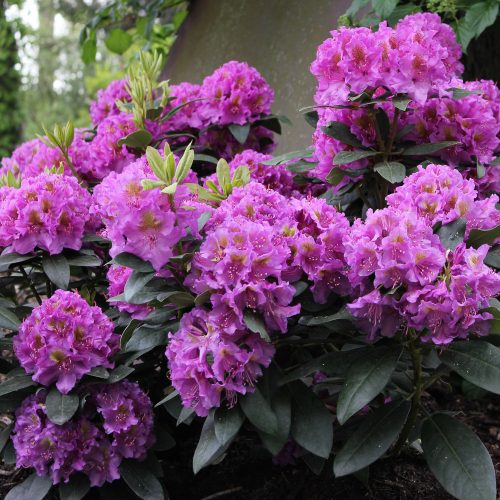
Pruning Flowering Evergreens like Spring Blooming Azaleas, Rhododendron, Distylium, Loropetalum and Rhaphiolepis
When to Prune: Prune immediately after flowering, if necessary. Pruning later may eliminate next year’s flower buds for shrubs that bloom on old wood. Exception: Prune camellias in early spring, and only if necessary.
How to Prune: Pruning is more of an art form with flowering evergreens of this sort. Prune only what’s necessary and take care to maintain the shrub’s natural shape rather than pruning them into a ball or box. Broken, dead or diseased branches may be removed in their entirety anytime during the growing season.
Pruning Evergreens with Scale-like Foliage Including Juniper and Chamaecyparis
When to Prune: May be tip pruned in early summer.
How to Prune: Evergreens with scale-like foliage typically require little pruning. If desired to control their growth when they are young, you can pinch off the current season’s new growth at the tips of the branches. However, this will not be sustainable once the plant grows too tall. This type of evergreen should not be sheared for two reasons: 1) It will be very difficult to maintain the sheared shape as the plant grows up out of your reach and 2) It would take the plant years to conceal the cuts with new foliage.
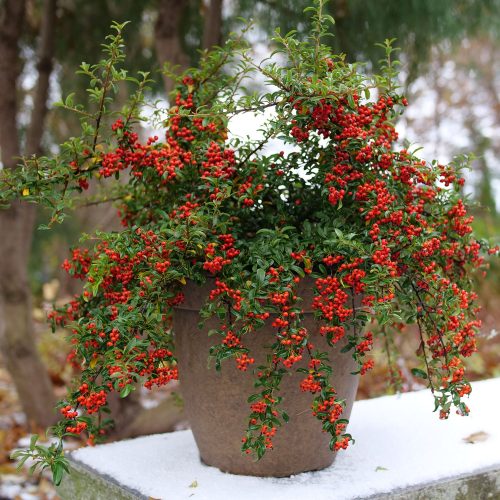
Don’t Prune These Evergreens
Unless it’s necessary to prune to remove dead, diseased or broken branches, it’s best to leave reblooming azaleas, gardenias, Leucothoe, Pieris and Berry Box® Pyracomeles alone. Pruning these evergreens will almost certainly remove their buds, future flowers or fruit. Also, their naturally graceful, unique shape can easily be spoiled by pruning.
Ready to explore all the evergreens we offer? Here are the lists:
Broadleaf and/or Flowering Evergreens
- Azalea and Rhododendron
- Buxus (boxwood)
- Camellia
- Distylium
- Elaeagnus (thornless silverthorn)
- Euonymus (wintercreeper)
- Gardenia
- Ilex meserveae (blue holly)
- Ilex crenata (Japanese holly)
- Ilex glabra (inkberry holly)
- Leucothoe (doghobble)
- Loropetalum (Chinese fringe-flower)
- Pieris (lily of the valley shrub)
- Pyracomeles
- Rhaphiolepis (Indian hawthorn)
- Sarcococca (sweet box)

